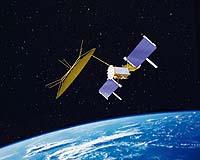 |
Reston VA (SPX) Feb 26, 2010 The U.S. Army has completed formal evaluation of the next-generation software version of the Force XXI Battle Command Brigade and Below (FBCB2), developed by Northrop Grumman. Field testing of the new software, called Joint Capabilities Release (JCR), was conducted at Fort Hood, Texas, from Sept. 28 to Nov. 20, 2009. FBCB2 is the key situational awareness and command-and-control system used by U.S. and coalition forces in Iraq and Afghanistan. The JCR upgrades include a significant increase in the network's bandwidth, allowing the combat-proven system to get more information to more users within seconds rather than minutes. It also provides a joint forces platform solution for both the Army and U.S. Marine Corps. The Army and Marine Corps continue conducting a series of planned tests at Fort Hood's Central Technical Support Facility and at Camp Pendleton, Calif., in the Marine Corps Tactical Systems Support Activity. Testing of the improved data throughput will continue throughout 2011, after the Army awards a production contract for an improved Blue Force Tracking 2 (BFT2) transceiver. The services expect to decide whether to field JCR in late summer 2010. "JCR will provide soldiers and Marines with powerfully enhanced capabilities in command-and-control and situational awareness," said Joe G. Taylor, Jr., vice president of the Ground Combat Systems operating unit within Northrop Grumman's Information Systems sector. "We are very optimistic a positive decision will be reached, and JCR will be fielded to operational units starting as early as October." During last fall's field testing, evaluators examined the effectiveness, reliability and performance of the system for both Army and Marines, in various military vehicles, tactical operations centers, called TOCs, and combat operations centers. The test was conducted in a distributed environment and supported by active-duty military and civilian personnel from several government agencies. Northrop Grumman completed system segment acceptance testing and delivered JCR to the U.S. Army Communications-Electronics Command, Fort Monmouth, N.J., in September 2009. Northrop Grumman developed JCR using an approach based on a common set of core assets, making it more modular, reusable, interoperable and easier to upgrade. This Battle Command Product Line architecture is capable of supporting multiple products for a variety of users, including aviation, dismounted soldiers, logistics and fires. JCR will be fielded to 96 percent of all Army and Marine Corps platforms that are scheduled to receive digital battle command systems. To date, more than 85,000 FBCB2 systems have been deployed worldwide. FBCB2 links communication devices, sensors, vehicles, rotary-wing aircraft and weapons platforms in a seamless digital network to provide a clear, continuous and common picture of the battlefield. Most FBCB2 systems communicate via a satellite-based network; about 30 percent use the Enhanced Position Location Reporting System, or EPLRS, tactical radio network. The company was awarded the first FBCB2 software development contract in January 1995.
Share This Article With Planet Earth
Related Links Northrop Grumman Read the latest in Military Space Communications Technology at SpaceWar.com
 Multi-Beam Antenna Integrated With First MUOS Satellite
Multi-Beam Antenna Integrated With First MUOS SatelliteSunnyvale CA (SPX) Feb 25, 2010 Employees at Lockheed Martin's facilities in Sunnyvale, Calif., inspect the first Mobile User Objective System (MUOS) satellite following the successful integration of the Multi Beam Antenna (MBA) with the spacecraft system module and core structure. Preparations are now underway to begin environmental testing of the fully integrated satellite, which will provide assured communications, in ... read more |
|
| The content herein, unless otherwise known to be public domain, are Copyright 1995-2010 - SpaceDaily. AFP and UPI Wire Stories are copyright Agence France-Presse and United Press International. ESA Portal Reports are copyright European Space Agency. All NASA sourced material is public domain. Additional copyrights may apply in whole or part to other bona fide parties. Advertising does not imply endorsement,agreement or approval of any opinions, statements or information provided by SpaceDaily on any Web page published or hosted by SpaceDaily. Privacy Statement |